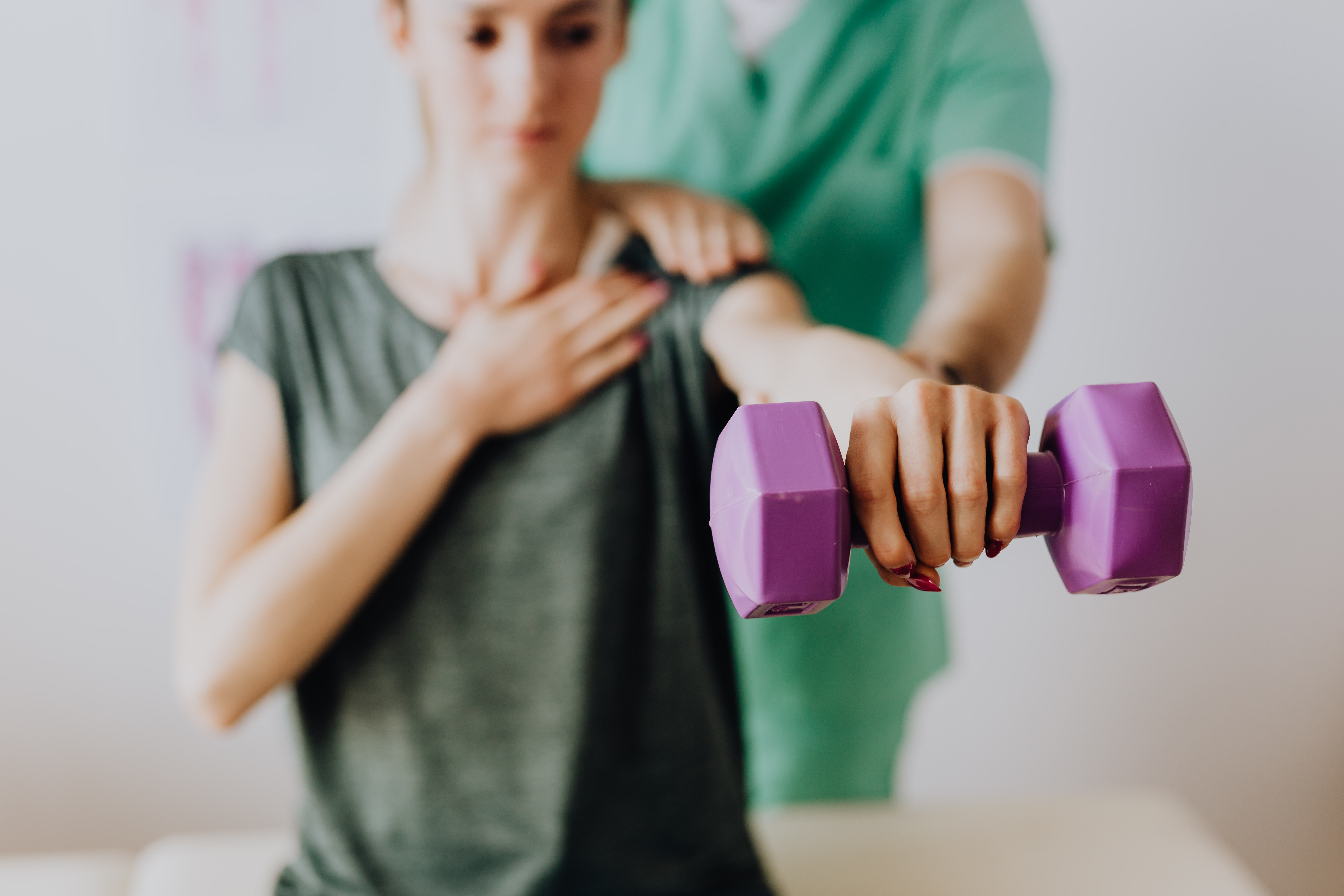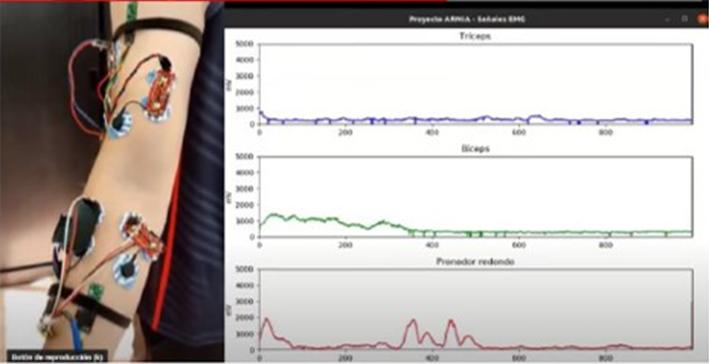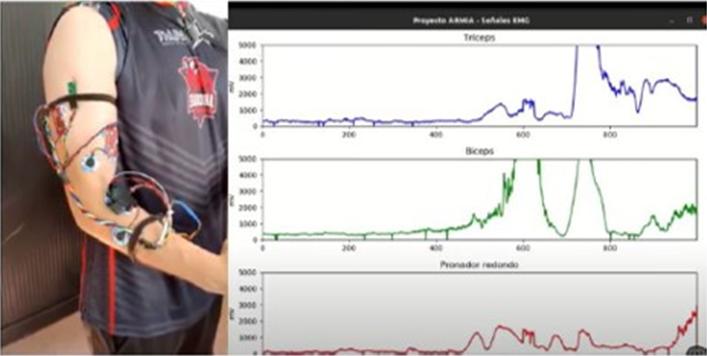Can we help you?
Contact us

Can we help you?
Contact us

Thank you for contacting us
Your form has been submitted successfully Our team will contact you again as soon as possible.
Whooppss...!! An error has occurred
Try sending later or write an email directly to areaempresas@ua.es

 PATENTED TECHNOLOGY
PATENTED TECHNOLOGY
INFO
SHEET
DOWNLOAD
EXECUTIVE
ABSTRACT
CONTACT DETAILS: Research Results Transfer Office-OTRI
University of Alicante
Tel.: +34 96 590 99 59
Email: areaempresas@ua.es
http://innoua.ua.es
The "Human Robotics" research group at the University of Alicante has developed a sensorised device for the rehabilitation of a body limb (preferably the upper limb).
This device consists of an elastic textile covering and inertial and electromyographic sensors attached to it, with which the patient's improvement will be monitored and evaluated, also allowing to adjust the exercises of simulated games, based on virtual reality and/or augmented reality applications. The system constitutes an integrated rehabilitation tool for people with mobility problems in the upper limb, easy to use and based on user motivation.
The technology, which is protected under patent application, has been developed at laboratory scale and a prototype is available for demonstration. Companies interested in the commercial exploitation of the device are sought.

In recent years, there has been a considerable increase in the number of people with motor disabilities, due to global ageing. For this reason, public and private healthcare systems are investing more in rehabilitation technologies, and especially in tele-rehabilitation both at home and in centres, as it helps to avoid unnecessary physical contact between patients and therapists, as well as improving the rehabilitation process by increasing repeatability and intensity.
Motor impairment of the limbs, in particular the upper limbs, is one of the most limiting conditions for activities of daily living, so effective rehabilitation is essential to regain quality of life. Over the last decades, a wide range of robot-assisted technologies have been developed that surpass the effectiveness of conventional manual therapies. Anthropomorphic devices, such as upper limb exoskeletons, are also common, although they are biomechanically more complex. However, all these technologies are expensive and unaffordable for individuals and most rehabilitation centres.
Due to the COVID-19 pandemic, existing rehabilitation services have been disrupted. This disruption, and the need to avoid patient visits and attendance at hospital or rehabilitation centres, reflects the importance of competitive, reliable, and accessible rehabilitation, tele-rehabilitation and home-based rehabilitation systems.
The research group of the University of Alicante "Human Robotics" has developed a sensorised device that allows the active physical rehabilitation of people with reduced mobility of a body limb, preferably an upper limb, by means of virtual and augmented reality.
The proposed device is composed of the following elements:
1. an adjustable sleeve (elastic textile covering) for the user's arm sensorised with inertial sensors or IMUs (Inertial Measurement Units) and EMG (ElectroMyoGraphy) type sensors; The former allow recording the orientation and movement of each of the kinematic links that make up the body limb, while the latter allow obtaining the raw value or linear envelope of the rectified signal of the electrical signals of the muscles.
2. a computer application to provide the user with active rehabilitation exercises based on virtual reality and/or augmented reality applications that monitor the patient's movements and propose specific exercises through the user interface, adapted to the patient's condition.
3. intelligent software for calculating the kinematics of the arm, in particular angular positions and velocities, and end position, by analysing data from inertial sensors and for adjusting exercises depending on the patient's muscle activity, such as force amplitude or fatigue, by analysing data from EMG sensors.
In addition, the sensorised device comprises:
• a power supply battery, for the correct power supply of all electronic components integrated in the textile cover;
• a DC-DC step-down transformer, so that the output voltage is kept constant regardless of disturbances or alterations in the input voltage, adapting the battery voltage to the voltage required by the microcontroller or means of control and the connected components;
• a plastic housing for all electronic components for better protection and isolation from interference and shock;
• means of controlling the inertial sensor and/or electromyographic sensor (microcontroller module);
• means of wireless transmission (wifi interface);
• a data processing device (computer, mobile phone, monitor, virtual/augmented reality glasses, or equivalent).
The following figure shows the hardware architecture of the device:

The blocks that make up the body limb kinematics calculation software are:
• the data acquisition block;
• the electromyographic processing block;
• the kinematic calculation block; and,
• the data visualisation block for use in the simulated games.
Thanks to the signals from these sensors, it is possible to analyse biomarkers relating to muscle fatigue or movement coordination. Thus, when faced with a movement generated by muscular activation, the combined analysis of both information, the kinematics of the inertial sensor on the one hand, and the muscular activation of the electromyographic sensor on the other, offers more precise information on the behaviour of the user or patient at a neuro-mechanical level. The difficulty of the rehabilitation exercises will be a function of the kinematics of the user's limb as determined by the calculation software.
TECHNOLOGY ADVANTAGES
The developed device has the following advantages:
• Reduced cost, providing greater accessibility to both individuals and rehabilitation centres;
• Competitive and reliable system;
• Easy portability;
• Ease of use;
• Based on the user's own motivation.
INNOVATIVE TECHNOLOGY ASPECTS
The main innovative aspects of this sensorised device are as follows:
• The use of a low-cost sensorised sleeve, which will make it a more accessible device.
• The application will not require the use of additional sensors and will be able to work with a laptop with webcam.
• Technology that allows individual home rehabilitation from home by the patient.
• Integral tool based on patient motivation (serious-games) and allowing the interface to adapt/adjust based on quantitative metrics of their motor function (fatigue, kinematics of the affected arm, force amplitude, etc.).
The technology is developed at laboratory scale and a prototype is available for demonstration. Below is a series of images of the device in operation:



The next steps will be the design of a pre-commercial prototype and its validation on a larger number of users.
The present invention falls within the field of wearable systems for the rehabilitation of a body member of a user, specifically an arm, although it can also cover the shoulder, chest and back, although it could alternatively be used for the leg.
This rehabilitation system would improve the recovery of the patient's upper limb motor function through adaptive therapy based on quantitative metrics, such as muscle activity, arm kinematics, force amplitude, ranges of motion, etc.
This rehabilitation device could be used by both individuals and rehabilitation centres.
Therefore, this technology would be useful in the fields of smart textiles, wearable systems, rehabilitation systems, tele-rehabilitation and home rehabilitation.
Companies interested in acquiring this technology for commercial exploitation are sought:
• Patent licensing agreements.
• R&D projects for the application of this technology in other body parts or in the field of sports.
• Proof of concept projects.
• Other related R&D projects.
Company profile sought:
• Companies manufacturing smart textiles or wearable systems for the medical sector.
• Companies manufacturing rehabilitation, tele-rehabilitation and home rehabilitation systems.
• Companies specialising in the development and marketing of medical devices.
This technology is protected by a patent application:
• Patent title: 'Sensorised device for rehabilitation of a bodily limb'.
• Application number: P202230528.
• Application date: 15 June 2022.

Carretera San Vicente del Raspeig s/n - 03690 San Vicente del Raspeig - Alicante
Tel.: (+34) 965 90 9959




